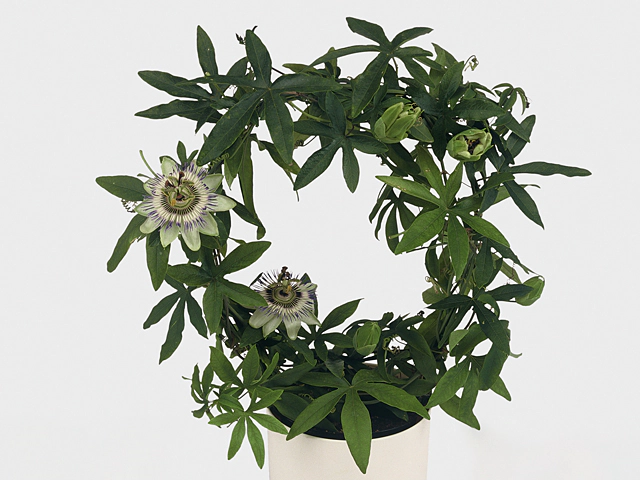Passiflora caerulea

| Fruit type | Berry |
| Leaf type | Foliage leaf |
| Winter hardness | Limited (USDA-zone 8) |
| Flower color | Blue-medium violet blue-094B; Green-light green-142C |
| Structure (tissues) | Subshrubby/semi-shrubby |
| Plant, growth type | Climbing |
| Leaf colour, pattern | Bicolored |
| Flower color distribution | Multi-colored; Bicolored |
| Toxicity (if consumed) | Fairly |
Passiflora caerulea, commonly known as the passion flower or passionflower, is a remarkable vine that features beautiful and intricate flowers. This plant belongs to the Passifloraceae family and is native to South America. It is now widely cultivated in various parts of the world for its attractive flowers and edible fruits.
One of the distinguishing features of Passiflora caerulea is its climbing growth habit. This vine can easily reach a height of 10 to 20 feet and spread equally wide. It has strong, twining stems that allow it to climb on trellises, fences, or any other support it can find. The lush foliage consists of foliage leaves that are green in color and have a bicolored pattern, adding visual interest to the plant even when it's not in bloom.
The flowers of the passion flower are truly a sight to behold. They have a unique structure with several layers of petals, providing an exotic and intricate appearance. The flower color distribution varies, with the outer petals usually being blue to medium violet-blue, while the inner petals are light green. This multi-colored and bicolored combination creates a stunning contrast that makes the passion flower a popular choice for gardens and landscapes.
Passiflora caerulea blooms mainly during the summer months, from June to September, attracting pollinators such as bees and butterflies with its nectar-filled flowers. These pollinators play a crucial role in the plant's reproductive cycle, ensuring the production of fruits.
The fruit of the passion flower is a berry that starts green and matures to a dark, purplish-black color. When fully ripe, the fruit is edible and has a sweet and tangy flavor. It is often used in jams, jellies, and desserts. It is worth noting that not all passion flower species produce edible fruits, so it is essential to ensure you have the Passiflora caerulea variety if you wish to enjoy the fruits.
While the passion flower is generally safe to admire and enjoy, it is important to note that some parts of the plant, including the leaves and stems, contain toxic compounds. If consumed in large quantities, these compounds can cause digestive upset and other mild symptoms. Therefore, it is advisable to be cautious around children and pets and avoid ingesting any part of the plant.
Passiflora caerulea is generally well-suited for growing in USDA hardiness zone 8 and higher, where winters are mild. In colder regions, it can be grown as an annual or brought indoors for overwintering. It thrives in well-drained soil and prefers a sunny location to ensure maximum flower production. Regular pruning is recommended to control its growth and to maintain its shape.
In conclusion, Passiflora caerulea, also known as the passion flower or passionflower, is a captivating plant with its climbing growth habit, intricate flowers, and edible fruits. While it demands some caution due to its toxicity if consumed, it remains a popular choice among gardeners and landscaping enthusiasts for its aesthetic appeal and unique features.
Market availability index by month:
| Jan. | Feb. | Mar. | Apr. | May | Jun. | Jul. | Aug. | Sep. | Oct. | Nov. | Dec. |
|---|---|---|---|---|---|---|---|---|---|---|---|
| - | 1 | 1 | 3 | 4 | 2 | 1 | 1 | - | - | - | - |